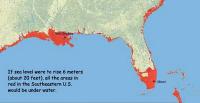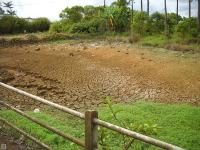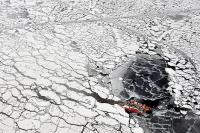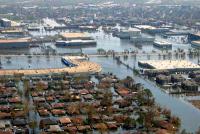-
Sea level rise: NASA watching waters rise right outside the front door – pt. 2

The rate of sea level rise is faster now than at any time in the past 2,000 years, and that rate has doubled in the past two decades. If ice sheets in Greenland and Antarctica continue to melt as quickly as current measurements indicate, those numbers could become 21 to 24 inches by the 2050s and 43 to 49 inches by the 2080s. Half to two-thirds of NASA’s infrastructure and assets stand within sixteen feet of sea level, so NASA is facing the same problem faced by about 55 to 60 percent of U.S. citizens, who live in counties touching the Atlantic or Pacific Ocean, the Gulf of Mexico, or the Great Lakes. Across the space agency, from lab manager to center director to NASA administrator, people will have continually to ask the question: is it time to abandon this place and move inland? It is a question everyone with coastal property in America will eventually have to answer.
-
-
How Western Europe came to dominate the globe

Although Europe represents only about 8 percent of the planet’s landmass, from 1492 to 1914, Europeans conquered or colonized more than 80 percent of the entire world. There are many possible explanations for why history played out this way, but few can explain why the West was so powerful for so long. Caltech’s Philip Hoffman, a professor of business economics and history, has a new explanation: the advancement of gunpowder technology. The Chinese invented gunpowder, but Hoffman argues that certain political and economic circumstances allowed the Europeans to advance gunpowder technology at an unprecedented rate — allowing a relatively small number of people quickly to take over much of the rest of the globe. What lessons does his explanation of the West’s rise to dominance offer for today’s policy makers? “In a world where there are hostile powers, we really don’t want to get rid of spending on improving military technology,” Hoffman says. “I would much rather see expenditures devoted to infrastructure, or scientific research, or free preschool for everybody – things that would carry big economic benefits,” and “I wish we did live in that world, but unfortunately it’s not realistic.”
-
-
NASA watching waters rise right outside the front door – pt. 1

For the past two centuries, two trends have been steady and clear around the United States. Sea level has been rising, and more people have been moving closer to the coast. As the ocean has warmed, polar ice has melted, and porous landmasses have subsided, global mean sea level has risen by eight inches since 1870. The rate of sea level rise is faster now than at any time in the past 2,000 years, and that rate has doubled in the past two decades. If ice sheets in Greenland and Antarctica continue to melt as quickly as current measurements indicate, those numbers could become twenty-one to twenty-four inches by the 2050s and forty-three to forty-nine inches by the 2080s. About 55 to 60 percent of U.S. citizens live in counties touching the Atlantic or Pacific Ocean, the Gulf of Mexico, or the Great Lakes. A recent study by business and finance leaders found that $66 billion to $106 billion worth of coastal property is likely to sit below sea level by 2050. The nation’s problem is also NASA’s problem, because half to two-thirds of NASA’s infrastructure and assets stand within sixteen feet of sea level.
-
-
No “democratic peace”: Democracies are as likely to fight each other as other types of government
Democratic peace is the widely held theory that democracies are less likely to go to war against each other than countries with other types of government. Using a new technique to analyze fifty-two years of international conflict, researchers suggest that there may be no such thing as a “democratic peace.” In the new study, researchers found that economic trade relationships and participation in international governmental organizations play a strong role in keeping the peace among countries. But democracy? Not so much. In addition, a model developed with this new technique was found to predict international conflict five and even ten years in the future better than any existing model.
-
-
Cleaning explosives pollution with plants
Biologists have taken an important step in making it possible to clean millions of hectares of land contaminated by explosives. The researchers have unraveled the mechanism of TNT toxicity in plants, raising the possibility of a new approach to explosives remediation technology. TNT has become an extensive global pollutant over the last 100 years and there are mounting concerns over its toxicity to biological systems.
-
-
What would it take to end California’s drought?
The excitement about a potentially rain-bearing El Niño is building, and hopes for a swift end to California’s ongoing drought are multiplying. At the same time, many of us who have worked extensively on water issues in the state fear the momentum and progress made on much-needed water reforms will be lost. This will be unfortunate, because California’s current water situation offers an invitation to expand how we think about water and drought conditions. A more nuanced perspective about what drought means and our water needs can help continue the momentum on the shifts, such as conservation measures and groundwater management, needed to deal with what is certainly an uncertain future.
-
-
Lost generation: Wars prevent 13m children in Middle East, north Africa from going to school
The UN children’s fund, in a report issued earlier today (Thursday) said that conflicts across the Middle East and North Africa have been preventing more than thirteen million children from attending school, undermining their hopes for a better future. “We’re on the verge of losing an entire generation of children in the Middle East and North Africa,” UNICEF regional director said.
-
-
Past strategies for managing droughts are obsolete in a hotter, more densely populated world

California’s current extreme drought must be a lesson for managing water in a warmer, more densely populated world, experts say. The Golden State has a long history of successfully managing droughts, but strategies from the past century are now obsolete, they assert. The current drought, which began in 2012, is a harbinger of what is to come. Engineering our way around periodic water shortages will no longer work in a hotter, drier world with ceaseless human demands on water supplies. Our ever-increasing thirst for water coupled with poor management, aging infrastructure and worsening climate change is a recipe not just for wells run dry, but for ravaged forests, extinct wildlife, and more droughts. Targeted research and public policies that move beyond a crisis response mentality are critically needed, the experts conclude.
-
-
Prepaid card reader helps law enforcement in seizing fraudulent cards
During arrests of criminal couriers, law enforcement officers rarely find bundles of cash wrapped in rubber bands anymore. Instead, they find stacks of plastic cards — bank credit and debit cards, retail gift cards, library cards, hotel card keys, even magnetic-striped Metrorail cards — which have been turned into prepaid cards. DHS S&T’s Electronic Recovery and Access to Data (ERAD) Prepaid Card Reader is a small, handheld device which uses wireless connectivity to allow law enforcement officers in the field to check the balance of cards. This allows for identification of suspicious prepaid cards and the ability to put a temporary hold on the linked funds until a full investigation can be completed.
-
-
Smaller cities in developing world unprepared for disaster
While many planners focus on the threat of natural disasters to major metropolises around the world, a new study shows smaller cities are often even less equipped to handle such catastrophes. In India, where his study was focused, the number of people living in such cities grew from 170 to 227 million over the past twenty years. This, however, has not prompted disaster planning experts to focus on how to safeguard these cities from the risk of floods, earthquakes, mudslides, and tidal waves. Many of those threats are even greater now due to climate change.
-
-
Rare but predictable storms could pose big hazards
Researchers at Princeton and MIT have used computer models to show that severe tropical cyclones could hit a number of coastal cities worldwide that are widely seen as unthreatened by such powerful storms.
The researchers call these potentially devastating storms Gray Swans in comparison with the term Black Swan, which has come to mean truly unpredicted events that have a major impact. Gray Swans are highly unlikely, the researchers said, but they can be predicted with a degree of confidence. The researchers examined potential storm hazards for three cities: Tampa, Florida; Cairns, Australia; and Dubai, United Arab Emirates.
-
-
Wearable device helps medics save lives in disasters, on the battlefield
The First Response Monitor is a wearable device designed to measure and monitor the vital signs of multiple trauma patients for emergency response in disasters and battlefield situations. The device has been primarily designed with first response medics in mass casualty incidents in mind, but it has applications in many other fields — such as civilian medicine where additional monitoring of conditions has benefit in patient outcomes, wellness monitoring, and within sports for training and performance monitoring.
-
-
A melting Arctic demands more – not less – research on earth science

The Arctic is melting rapidly. Who cares? Anyone who is concerned about the rising price of food, lives near the coast, shoveled snow all winter, can’t water their lawn anymore, pays a bigger premium now for property insurance, or enjoys eating seafood. Did we leave anyone out? Apparently so, yet this group of people should care as much as anyone. The House of Representatives earlier this year slashed NASA’s earth sciences research budget, which funds much of the research U.S. scientists do on the Arctic. Scientific research is not a luxury to be indulged. It is an essential contributor to our national well-being, helping us avoid costly mistakes while finding new ways to improve our security, our economy, and our quality of life. Today, Congress is taking us on a course toward an Arctic legacy of myopia, feebleness, and ignorance. Rather than denying the changes that affect us all, they should be steering our national policies toward scientific excellence and vigorous action on challenges such as Arctic meltdown and its impacts. Nowhere is the evidence clearer; never has the need for research been more urgent. We ignore the Arctic at our peril.
-
-
Sea level rise unevenly, which is bad news for some coastal regions

When you fill a sink, the water rises at the same rate to the same height in every corner. This is not the way it works with our rising seas. Tides, winds, and ocean currents play a role in these regional differences, but an increasingly important mover and shaker is the solid Earth itself. Global warming is not just affecting the surface of our world; it is making the Earth move under our feet. These regional differences in sea level change will become even more apparent in the future, as ice sheets melt. For instance, when the Amundsen Sea sector of the West Antarctic Ice Sheet is totally gone, the average global sea level will rise four feet. The East Coast of the United States, however, will see an additional fourteen to fifteen inches above that average.
-
-
Sea-level rise handbook to help land managers, coastal planners, and policy makers

Coastal managers and planners now have access to a new U.S. Geological Survey (USGS) handbook which, for the first time, comprehensively describes the various models used to study and predict sea-level rise and its potential impacts on coasts. The handbook, designed for the benefit of land managers, coastal planners, and policy makers in the United States and around the world, explains many of the contributing factors that account for sea-level change.
-
More headlines
The long view
New Technology is Keeping the Skies Safe
DHS S&T Baggage, Cargo, and People Screening (BCP) Program develops state-of-the-art screening solutions to help secure airspace, communities, and borders
Factories First: Winning the Drone War Before It Starts
Wars are won by factories before they are won on the battlefield,Martin C. Feldmann writes, noting that the United States lacks the manufacturing depth for the coming drone age. Rectifying this situation “will take far more than procurement tweaks,” Feldmann writes. “It demands a national-level, wartime-scale industrial mobilization.”
How Artificial General Intelligence Could Affect the Rise and Fall of Nations
By Barry Pavel et al.
Visions for potential AGI futures: A new report from RAND aims to stimulate thinking among policymakers about possible impacts of the development of artificial general intelligence (AGI) on geopolitics and the world order.
Smaller Nuclear Reactors Spark Renewed Interest in a Once-Shunned Energy Source
By David Montgomery
In the past two years, half the states have taken action to promote nuclear power, from creating nuclear task forces to integrating nuclear into long-term energy plans.
Keeping the Lights on with Nuclear Waste: Radiochemistry Transforms Nuclear Waste into Strategic Materials
By John Domol
How UNLV radiochemistry is pioneering the future of energy in the Southwest by salvaging strategic materials from nuclear dumps –and making it safe.
Model Predicts Long-Term Effects of Nuclear Waste on Underground Disposal Systems
By Zach Winn
The simulations matched results from an underground lab experiment in Switzerland, suggesting modeling could be used to validate the safety of nuclear disposal sites.
